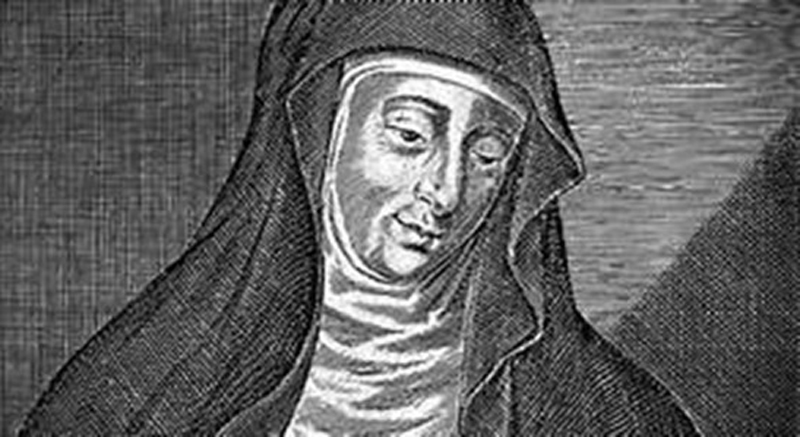(1098-1179)
Hildegard of Bingen was the 10th child of a well-to-do family of West Franconia (now Germany).
She had visions connected with illness (perhaps migraines) from a young age, and in 1106 her parents sent her to a 400-year-old Benedictine monastery that had only recently added a section for women. They put her under the care of a noblewoman and resident there named Jutta, calling Hildegard the family’s “tithe” to God.
Jutta, who would become abbess of the convent, taught Hildegard to read and write. For many young women of noble background, convents were often places of learning, a welcome home to women who had intellectual gifts. Hildegard, as was true of many other women in convents at the time, learned Latin, read the scriptures, and had access to many other books of religious and philosophical nature.
Those who have traced the influence of ideas in her writings find that Hildegard must have read quite extensively. Part of the Benedictine rule required study, and Hildegard clearly availed herself of the opportunities.
When Jutta died in 1136, Hildegard was elected unanimously as the new abbess. Rather than continue as part of a double house—a monastery with units for men and for women— Hildegard in 1148 decided to move the convent to Rupertsberg, where it was on its own and not directly under the supervision of a male house. This gave Hildegard considerable freedom as an administrator, and she traveled frequently in Germany and France.
She claimed that she was following God’s order in making the move, adamantly opposing her abbot’s objection. She assumed a rigid position, lying like a rock until he gave his permission for the move. The move was completed in 1150.
The Rupertsberg convent grew to as many as 50 women and became a popular burial site for the wealthy of the area. The women who joined the convent were of wealthy backgrounds, and the convent did not discourage them from maintaining something of their lifestyle. Hildegard of Bingen withstood criticism of this practice, claiming that wearing jewelry to worship God was honoring God, not practicing selfishness.
Part of the Benedictine rule is labor, and Hildegard spent early years in nursing and at Rupertsberg in illustrating (“illuminating”) manuscripts. She hid her early visions; only after she was elected abbess did she receive a vision that she said clarified her knowledge of “the psaltery…the evangelists and the volumes of the Old and New Testament.” Still showing much self-doubt, she began to write and share her visions.
During her time there were conflicts between the papacy and the Holy Roman Emperor as well as a papal schism. Hildegard of Bingen, through her many letters, took to task both the German Emperor Frederick Barbarossa and the archbishop of Main. She wrote to such luminaries as King Henry II of England and his wife Eleanor of Aquitaine. She also corresponded with many individuals of low and high estate who wanted her advice or prayers.
Our saint could be truly stubborn in her convictions. A final famous incident happened near the end of Hildegard’s life when she was in her 80s. She allowed a nobleman who had been excommunicated to be buried at the convent, seeing that he had last rites. She claimed she had received word from God allowing the burial. But her ecclesiastical superiors intervened and ordered the body exhumed. Hildegard defied the authorities by hiding the grave, and the authorities excommunicated the entire convent community.
Most insultingly to Hildegard, the interdict prohibited the community from singing. She complied with the interdict, avoiding singing and communion, but did not comply with the command to exhume the corpse. Hildegard appealed the decision to yet higher church authorities and finally had the interdict lifted.
Before her death, Hildegard left an ample written legacy. Her best-known writing is a trilogy (1141–1152) including Scivias, Liber Vitae Meritorum, (Book of the Life of Merits), and Liber Divinorum Operum (Book of the Divine Works). These include records of her visions—many are apocalyptic—and her explanations of scripture and salvation history.
She also wrote plays, poetry, and music, and many of her hymns and song cycles are recorded today. She even wrote on medicine and nature—and it is important to note that for Hildegard of Bingen, as for many in medieval times, theology, medicine, music, and similar topics were united, not separate spheres of knowledge.
Hildegard of Bingen died on Sept. 17, 1179, at age 82. Perhaps because of her famous (or infamous) flouting of ecclesiastical authority, Hildegard of Bingen was not initially canonized by the Roman Catholic Church as a saint, although she was honored locally as a saint. The Church of England considered her a saint. On May 10, 2012, Pope Benedict XVI officially declared her a saint of the Roman Catholic Church. Later that year on October 7, he named her a Doctor of the Church (meaning her teachings are recommended doctrine). She was the fourth woman to be so honored, after Teresa of Avila, Catherine of Siena, and Térèse of Lisieux.
Adapted by A. J. Valentini from: Biography of Hildegard of Bingen, Mystic, Writer, Composer, Saint. (n.d.). ThoughtCo. Retrieved Dec. 8, 2020, from https://www.thoughtco.com/hildegard-of-bingen-3529308
